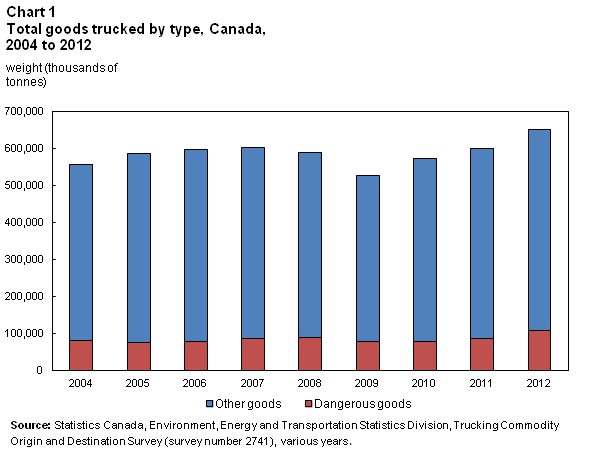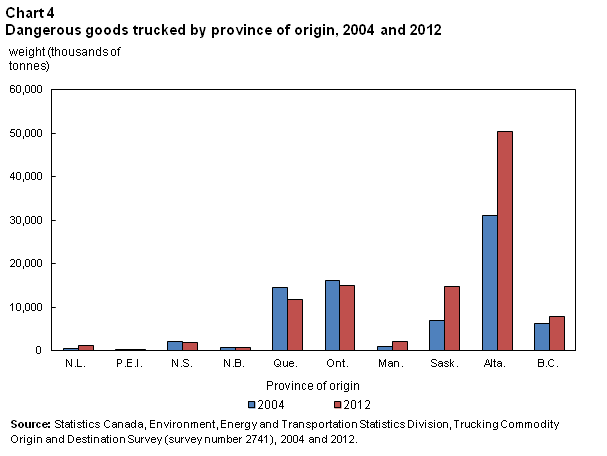Trucking dangerous goods in Canada, 2004 to 2012
Archived Content
Information identified as archived is provided for reference, research or recordkeeping purposes. It is not subject to the Government of Canada Web Standards and has not been altered or updated since it was archived. Please "contact us" to request a format other than those available.

by Sagal Searag, Greg Maloney and Larry McKeown, Environment, Energy and Transportation Statistics Division
[Release from The Daily] [Full article in PDF]
- Introduction
- What you should know about this study
- Increasing weight shipped
- Road versus rail
- The top four dangerous goods
- Average distance
- Provincial perspectives
Start of text box
Highlights
- The Canadian for-hire trucking industry moved 650 million tonnes of freight in 2012, of which almost 17% consisted of dangerous goods.
- In 2012, crude petroleum products accounted for the largest share of dangerous goods at over one-third (38%), up from one-quarter (25%) in 2004.
- During 2012, the for-hire trucking industry is estimated to have transported approximately four times the dangerous goods by weight than did railways.
End of text box
Introduction
Recent events have heightened public awareness concerning the transportation of dangerous goods. While economic regulation of Canada’s transportation sector has been reduced over the last 25 years, the movement of dangerous goods continues to be carefully regulated. Compared to other freight, shipments of explosives, gases, flammable liquids, flammable solids, oxidizing substances, poisonous and infectious substances, nuclear substances, corrosives and other products pose public safety and environmental risks.Note 1 The consequences of accidents or spills can be severe, particularly if shipments travel through population centres or fragile ecosystems.Note 2
Regulations on the movement of dangerous goods can vary by jurisdiction but generally require accurate classification, appropriate means of containment, and correct marking, labelling and documentation. In Canada, federal legislation currently prohibits the transportation of certain high risk dangerous goods unless an Emergency Response Assistance Plan (ERAP) has been submitted and approved. The plan outlines how specialized emergency response personnel will react to an accident and their overall capacity to respond. As dangerous goods are likely to remain a significant portion of the overall freight moved across the country, there is a recognized need to further enhance the monitoring of these shipments.
For instance, in June of 2014 Transport Canada amended the Transportation of Dangerous Goods Regulations to clarify the criteria for displaying safety marks.Note 3 The regulation now requires safety marks to be displayed on trucks, rail cars and bulk containers used to transport dangerous goods, identifying the type of goods and the nature of the risk posed. And in August, Transport Canada launched the second stage of consultations concerning adequate railway third party liability insurance in order to cover, among other costs, the spill of contaminants and environmental damage related to railway operation.Note 4
Surface transportation (i.e., road and rail excluding pipelines) is estimated to move almost 95% of the total tonnage of dangerous goods in Canada with trucking accounting for the largest share.Note 5 The possibility that accidents might occur at any time or any location between the origin and destination raises questions concerning the nature of these types of shipments. To provide some perspective, this study examines the dangerous goods transported by the Canadian for-hire trucking industry from 2004 to 2012, focusing on tonnage, types of goods and average distance per shipment.
Start of text box
What you should know about this study
Statistics Canada’s Trucking Commodity Origin and Destination Survey (TCOD) targets large (annual revenue > $1.3 million) establishments in the Canadian for-hire trucking industry (North American Industry Classification System 484). It excludes foreign-based trucking establishments operating in Canada and non-trucking establishments with their own fleets (i.e., private trucking). As such, TCOD estimates should be considered as a lower boundary of total trucking activity in Canada. For comparison, for-hire trucking establishments in the United States accounted for just 58% of dangerous goods trucked by weight in 2012, but averaged over 4.5 times the distance shipped.
Over the study period, the number of target establishments ranged roughly from 2,100 to 2,900; in 2012, 92% of 2,196 establishments responded to the survey. Statistics Canada interviewers visit each establishment and, using a systematic sample of shipping documents, record information on the origin and destination of shipments as well as the weight and type of goods. The coefficient of variation (CV) by weight was calculated at less than 5% for all types of shipments in 2012.
Commodities are classified to a Standard Classification of Transported Goods (SCTG) aggregation, which includes about 500 groups. In many cases, all commodities in a group are considered dangerous while, in other groups, some are dangerous and others are not. In the second case, an algorithm based on Transport Canada information is used to apply a flag that reflects the likelihood that the shipment includes dangerous goods. In 2012, 97% of shipments by weight flagged as dangerous goods were classified to SCTG groups in which all goods are dangerous, such as Petroleum products. In comparison, shipments of Glues and prepared glues were considered as dangerous 18% of the time.
End of text box
Increasing weight shipped
In 2012, the combined weight of all commodities moved by Canadian for-hire trucking establishments reached over 650 million tonnes, a record amount culminating from steady growth experienced following the 2009 economic downturn (Chart 1). A key portion of these shipments in 2012 consisted of dangerous goods at just over 107 million tonnes (17% of all goods), up from the 81 million tonnes (or 14%) trucked in 2004. This represents an increase of 32% since 2004, almost twice the rate of growth of the industry’s overall shipments (17%) during this same period.

Road versus rail
Recent derailments have served to increase the level of scrutiny associated with the movement of dangerous goods by rail.Note 6 However, a larger tonnage of dangerous goods is transported by truck. In 2012, the for-hire trucking industry handled approximately four times the dangerous goods by weight than did the mainline railways (Chart 2).Note 7 In the United States, but including private trucking carriers, about 93% of the more than 1.6 billion tons of dangerous goods transported by surface moved by truck.Note 8

Despite carrying more dangerous goods by weight, the consequences of an accident by truck are limited to a small number of trailers on a per truck basis. And moreover, the average shipments by truck involve shorter distances.Note 9 Shipments of dangerous goods by truck and rail would be therefore more comparable on a per tonne-kilometre basis. However, it should also be noted that most accidents and spills of dangerous goods occur during handling rather than during actual transit.Note 10
The top four dangerous goods
Although the top four dangerous goods trucked by weight remained the same over the study period, they accounted for almost 80% of the total by 2012, up from 71% in 2004 (Chart 3). The increase was driven largely by the trucking of crude petroleum products, which more than doubled to reach over 40 million tonnes by 2012, accounting for more than one-third (38%) of the total.
Over the same period, shipments of gasoline and aviation turbine fuel rose 11% to 26 million tonnes, while fuel oils increased 16% to 12.4 million tonnes and non-metallic minerals (such as sulphur) rose 43% to 5.2 million tonnes. Fertilizers and fertilizer materials (including nitric acid, sulphonitric acids and ammonia), the fifth largest category of dangerous goods trucked in 2012 at 2.6 million tonnes, increased by approximately 180% over the study period.

Average distance
An interesting factor is the distance that dangerous goods travel to reach their destination. From 2004 to 2012, the average distance of all shipments trucked in Canada was estimated to have increased from 608 to 632 kilometres. However, shipments of dangerous goods declined from an average of 316 to 269 kilometres. This decline reflects an increase in energy-related shipments, particularly crude petroleum products since, on average, shipments of these products travelled about one-third (35%) of the distance than did other dangerous goods (Table 1).
| Shipment type | kilometres |
|---|---|
| Dangerous goods | |
| Crude petroleum products | 110 |
| Other dangerous goods | 313 |
| Non-dangerous goods | 665 |
| All shipments | 632 |
| Source: Statistics Canada, Environment, Energy and Transportation Statistics Division, Trucking Commodity Origin and Destination Survey (survey number 2741), 2012. | |
A shorter average distance for trucking crude petroleum products is partly tied to extraction areas in Alberta and Saskatchewan and proximity to trans-loading facilities.
For Alberta, the oil sands region in the north of the province has limited rail service and pipeline access. Consequently, heavy oil is often trucked to feeder pipelines which serve consolidation points in the Edmonton area for rail and further southeast for pipeline.Note 11 In 2012, shipments of crude petroleum products were trucked an average distance of 95 km in Alberta.
For Saskatchewan, although its Bakken region in the south of the province has extensive rail coverage, there has been insufficient feeder pipeline infrastructure. Although the majority of crude is shipped out of the region by rail, it must first be trucked to a rail loading facility. On average, crude petroleum products were trucked a distance of 118 km in Saskatchewan.
Provincial perspectives
By province of origin, Alberta accounted for almost half of the national total weight of dangerous goods transported by truck in 2012 (Chart 4). The province also experienced the largest growth, increasing by over 19 million tonnes from 2004 to 2012. Again, this growth was driven largely by crude petroleum products as shipments of these products that originated in Alberta more than doubled from almost 15 million tonnes in 2004 to over 30 million tonnes by 2012.

Similarly for Saskatchewan, crude petroleum products shipped by truck rose from about 5 million tonnes to over 9 million tonnes. Combined with increased shipments of gasoline and aviation turbine fuel as well as fuel oils, fertilizers and fertilizer materials, the weight of dangerous goods shipped in the province reached 14.7 million tonnes by 2012.
Over the study period, British Columbia and Manitoba experienced some growth in shipments while Ontario and Quebec both experienced a decline in the tonnage of dangerous goods transported by truck.
Although provincial patterns of dangerous goods shipped by truck will evolve, crude petroleum products in the west are likely to continue driving national estimates by weight. In Alberta for instance, total crude oil production per month has risen from an average of 9.3 million cubic metres in 2010 to 12.5 million cubic metres during the first half of 2014,Note 12 largely from synthetic crude oil and crude bitumen extraction. And truck-to-rail delivery is now considered as a medium term alternative to access those areas not served directly by pipelines.Note 13
Notes
- Date modified:
